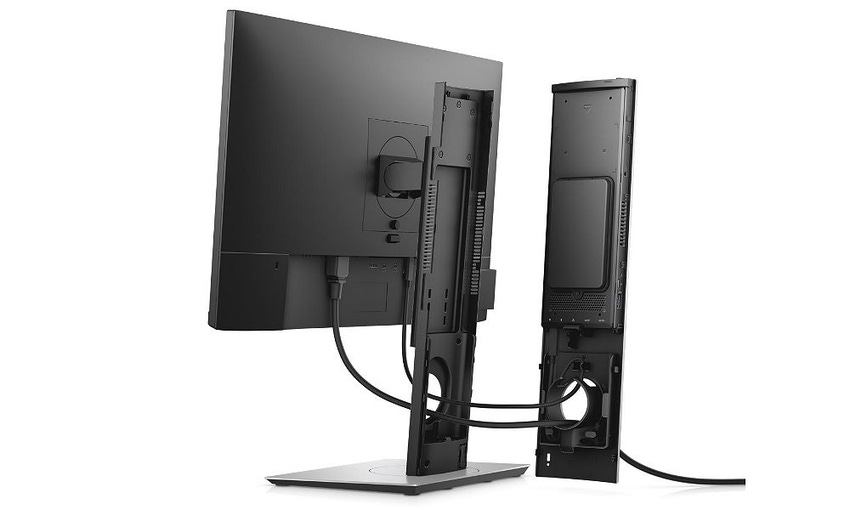The smaller and lighter OptiPlex 7070 Ultra is set to ship Sept. 24.
August 21, 2019

Dell is looking to up the ante in the commercial desktop market with a new form factor that is notably small, yet available, with a sizable set of with features and configuration options.
The new OptiPlex 7070 Ultra, announced this week and set to ship Sept. 24, can snap into rear panels of most commercial displays. The units, which weigh just 1.43 pounds, are designed as an alternative to an all-in-one. The benefit over an all-in-one is that a desktop upgrade is simplified by replacing the modular units with existing displays. Likewise, customers can upgrade displays without having to replace the PC components.
During a private demo of the unit last month, company officials said the new OptiPlex is designed as a replacement for all-in-ones or any office or industrial work environment where space is at a premium. Dell is certainly not the first to release a small form factor desktop: Lenovo offers the popular ThinkCentre Tiny Line (the new M720 measures 7.05 inches x 7.2 inches x 1.36 inches) and HP recently upgraded its ProDesk Mini (6.97 inches x 1.35 inches x 6.88 inches) line. But both weigh more than the OptiPlex 7070 Ultra, which is longer, but narrower and thinner, measuring just 10.09-inches long, 3.78 inches wide and 0.78-inches deep.
Dave Lincoln, vice president of Dell’s fixed computing business, said the new smaller and lighter form factor is the result of a multiyear research and development effort that he believes will have a significant impact on the commercial desktop business.

Dell’s Dave Lincoln
“I’m not suggesting that what we’re about to launch is like us finding electricity, but nevertheless, we do believe it’s the most radical, the most inventive thing to happen to this space, since the all-in-one in the late ’90s,” Lincoln told Channel Futures.
In a recent private demo, Dell emphasized that the new OptiPlex 7070 Ultra units are designed to snap into a display’s adjustable or fixed stand or VESA mount unobtrusively. Dell is offering configurations ranging from an Intel 8th Generation Core i3 processor with 4GB of RAM and a 500 GB SATA hard drive to an i7 with vPro security, 64GB of RAM and a 1 TB, Gen 3 PCIe x4 NVMe SSD. It also supports a secondary drive.
A DisplayPort output and two USB-C ports allow a single system to daisy chain across up to three monitors. During a demo of the system, company officials noted it works not just with Dell displays but any with USB-C support. Additional USB-A ports are at the bottom of the device. An internal wireless radio supports the new Wi-Fi 6 specification, also known as 802.11ax.
Industry analyst Anurag Agrawal of Techaisle said the form factor will appeal to users such as bank tellers, health care providers, receptionists, manufacturing assembly lines and others who are in tight workspaces. But he described the mini desktop as a niche market.

Techaisle’s Anurag Agrawal
“I suppose it’s a nice replacement for an all-in-one but it would be more appealing if they had a GPU option,” Argrawal said. “Dell is not the first to do this, but it’s a cool configuration and for some it will break a psychological barrier in considering configurable systems,” added Bob O’Donnell, principal analyst with Technalysis.
While Dell may have an edge on size and weight, HP offers more processor options. For example, HP’s ProDesk 405 G4 Mini comes with AMD Ryzen processors, and the company last month rolled out the new ProDesk 600 G5 Desktop Mini, which is available with Intel’s new 9th Generation CPUs. Dell said it’s already working on the next iteration of the OptiPlex 7070 Ultra but declined to elaborate.
In addition to the new OptiPlex 7070 Ultra, Dell said it will be rolling out a new tower, the OptiPlex 7171. The company said the new system will be available with Intel 9th Gen processors, up to the new 95-watt 8-core CPU with vPro. The new tower is targeted at commercial users that are looking to deploy visual and virtual reality content.
Read more about:
VARs/SIsAbout the Author(s)
You May Also Like


